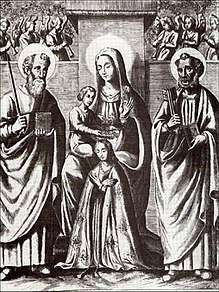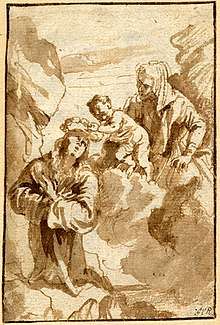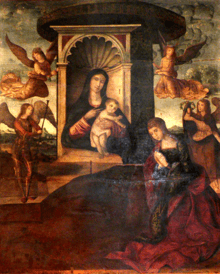Coronation of Saint Rosalia
The Coronation of Saint Rosalia or Madonna and Child with Saints Rosalia, Peter and Paul is a 1629 oil on canvas painting by Anthony van Dyck.
| The Coronation of Saint Rosalia | |
|---|---|
 | |
| Artist | Anthony van Dyck |
| Year | 1629 |
| Type | oil on canvas |
| Dimensions | 275 cm × 210 cm (108 in × 83 in) |
| Location | Kunsthistorisches Museum, Vienna |
It and the compositionally-similar The Vision of the Blessed Hermann Joseph (1630[1]) were both produced for the chapel of the Confraternity of the Celibates (Sodaliteit van de Bejaerde Jongmans in Flemish) in Antwerp's Jesuit church, Saint Ignatius[2]. They remained there until 1776, when archduchess Maria Theresa of Austria acquired them, taking them to Vienna, where they both now hang in the Kunsthistorisches Museum.[3]
History
.jpg)

It was the last painting the artist produced of Saint Rosalia and - with Saint Rosalia Interceding for the City of Palermo (also 1629) - represented a return to a subject of whom he had produced five paintings whilst trapped in her home city of Palermo during a plague in late 1624 and early 1625. The chapel in which it was to hang housed relics of the saint sent to the city by the Jesuits during a plague there in 1626 in the hope of spreading her cult beyond Sicily via major trading cities in the Spanish Netherlands - she was invoked against plague.[4] They also tried to spread her cult from their church in Ypres, for which they commissioned Gaspar de Crayer's Coronation of Saint Rosalia (Museum of Fine Arts, Ghent) in 1644, a work heavily influence by Paulus Pontius's print of van Dyck's version of the subject.
The Jesuits had been particularly active in promoting Saint Rosalia's cult in Sicily and beyond[4] and one of their number had produced her first hagiography in 1627, entitled Vitae Sanctae Rosaliae, Virginis Panormitanae e tabulis, situ ac vetustate obsitis e saxis ex antris e rudieribus caeca olim oblivione consepultis et nuper in lucem.[4] Van Dyck was given the commission partly because he was himself a member of the Confraternity, though he did accept a fee relatively low considering his fame at the time, and partly due to his six earlier works showing the saint.

Van Dyck may have met Cascini and the other Palermo Jesuits in 1624–1625, another possible reason for the commission.[4] He was also already producing drawings of the saint for engravings in Vita S.Rosaliae Virginis Panormitanae Pestis patronae iconibus expressa, published in Antwerp in 1629. Only one copy of the book survives, published by Cornelis Galle, a Flemish printer and engraver who had already produced the engravings for the Jesuits' Vita Beati Patris Ignatii Loyolae Religionis Societatis Iesu Fundatoris, a biography of their founder Ignatius of Loyola published in Antwerp in 1610. These drawings by van Dyck, the resulting engravings and the painting itself all show a strong influence from the prints illustrating Cascini's 1627 biography.[5][4]
Analysis
In both Coronation and his 1624-1625 paintings of the saint, van Dyck drew heavily on prints after works by Sicilian artists, though mainly for themes and details rather than style or composition.[6] It shows the Madonna and Child flanked by saint Paul and saint Peter, with their usual attributes of a sword and keys. The Christ Child crowns Saint Rosalia, who kneels before them, reproducing the composition of an engraving in Cascini's Vitae Sanctae Rosaliae. That engraving derived from a lost 1494 painting by Tommaso De Vigilia once in Santa Rosalia church in Bivona in western Sicily.[7]

Rosalia's rich brocaded mantle is unprecedented in earlier Flemish art showing the saint, which had usually shown her alone in a poor Franciscan-type habit. This detail is probably also drawn from a print but may also show the influence of the earlier c.1506 oil on panel painting by Riccardo Quartararo, showing Rosalia in royal clothing adorning the enthroned Madonna and Child.[8]
However, Sicilian works did not influence the composition or style of Coronation, which instead show the Venetian influence van Dyck had picked up during his time in Italy, a decisive influence on the formation of his style.[9] The brightly-lit colours and the diagonal formed by the Madonna, Child and Saint Rosalia are very similar to Paolo Veronese's 1575 Mystic Marriage of Saint Catherine, clearly van Dyck's main model for Coronation.[9] The skull, lily and roses are all typical attributes of Saint Rosalia, with the last two not only shown woven into the crown but also carried in the basket of the figure at the extreme right of the painting (probably quoting Titian's c.1550 Prado Salome) and held by the cherubs in the top right-hand corner.[9]
References
- Carolyn Diskant Muir, Art and Religion in Seventeenth-Century Antwerp: van Dyck's "Mystic Marriage of the Blessed Hermann-Joseph", in Simiolus. Netherlands quarterly for the history of art, Vol. 28, No. 1/2 (2000 - 2001), p. 56.
- Salomon, Xavier F. (2012). Van Dyck in Sicily 1624-1625 : Painting and the Plague. Milan: Silvana Editoriale Spa. p. 45-46. ISBN 8836621724.
- Jeffery Chipps Smith, The Jesuit Artistic Diaspora in Germany after 1773, in Robert A. Maryks and Jonathan Wright (editors), Jesuit Survival and Restoration: A Global History, Leida-Boston, 2015, p. 133.
- (in Italian) Fiorenza Rangoni Gàl, Lo "Sposalizio mistico di S. Rosalia" nella chiesa del S. Salvatore a Vercana. Un problema risolto? Con alcune considerazioni sulla elaborazione dell’iconografia rosaliana di Anton van Dyck (2ª parte), in Quaderni della biblioteca del convento francescano di Dongo, Dicembre 2013, pp. 54-63.
- Zirca Zaremba Filipczak, Van Dyck’s «Life of St. Rosalie», in The Burlington Magazine, CXXXI, n. 1039, 1989, p. 693.
- Gauvin Alexander Bailey, Anthony van Dyck, the Cult of Saint Rosalie, and the 1624 Plague in Palermo, G.A. Bailey (editor), Hope and Healing: Painting in Italy in a Time of Plague 1500–1800, Chicago, 2005, p. 118
- (in Italian) Michele Cometa, Descrizione e desiderio: i quadri viventi di E. T. A. Hoffmann, Milano, 2006, p. 139
- (in Italian) Cesare Matranga, Dipinti di Antonio van Dijck e della sua scuola nel Museo Nazionale di Palermo, in Bollettino d'Arte, 1908, Anno II, Serie I, Fascicolo I, p. 14.
- (in Italian) Maria Grazia Bernardini (editor), Van Dyck. Riflessi italiani (exhibition catalogue; Milano, Palazzo Reale, 2004), Milano, 2004, p. 167.